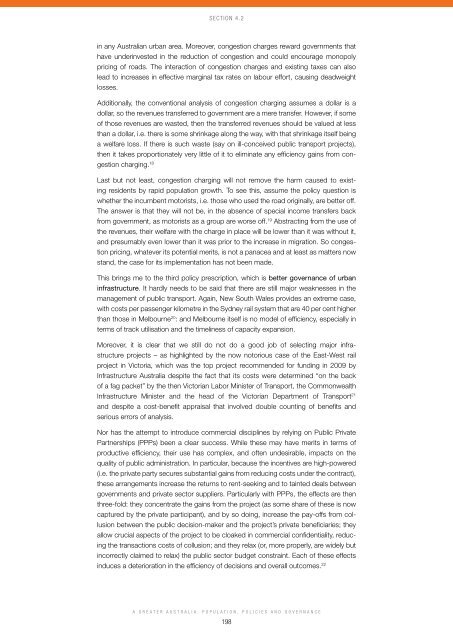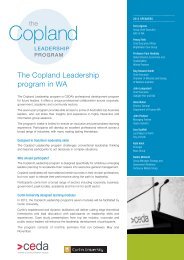Section 4.2Doing better in futureIn short, <strong>Australia</strong>n cities have at best postponed, rather than resolved, their difficulties.As the resulting tensions come to the fore, it is unsurprising that local residents arereluctant to accept sustained population growth. The question then is whether thereare policy changes that might ease the current constraints. Four points can be madein this respect.First, particularly in the area of l<strong>and</strong> use, clearer policy objectives would help. L<strong>and</strong>is a resource like any other; the goal of policy should be to ensure it is used efficiently.Subject to avoiding monopoly pricing, policy ought to aim at maximising l<strong>and</strong>’s unimprovedvalue, which implies ensuring its allocation to most highly valued uses. 15 Incontrast, the general approach to l<strong>and</strong> use policy in <strong>Australia</strong> is to define a smorgasbordof often conflicting <strong>and</strong> poorly thought through objectives, as the Council of <strong>Australia</strong>nGovernments (COAG) has recently done. 16COAG’s “capital city strategic planning systems criteria” includes elements such as“social inclusion, health, liveability, community wellbeing, <strong>and</strong> matters of nationalenvironmental significance”, as well as “encouraging world-class urban design <strong>and</strong>architecture,” apparently without regard to cost, <strong>and</strong> in any event with no indicationof how trade-offs between these myriad goals should be evaluated. To make mattersworse, despite nine primary criteria <strong>and</strong> over 20 sub-criteria, COAG’s list does notinclude ensuring efficient use of l<strong>and</strong>. Given such confusion at the body that is supposedto be providing strategic guidance, it is hardly surprising l<strong>and</strong> use outcomes areunsatisfactory.Second, in terms of the instruments that should be used to pursue those objectives,better pricing has a key role. In respect of infrastructure such as electricity, gas <strong>and</strong>water, there is a strong case in equity <strong>and</strong> efficiency for ensuring additional users bearthe incremental costs of their supply, most directly through developer charges for thecapital costs of extensions. This contrasts greatly with the current arrangements, whichlimit developer contributions <strong>and</strong> set user charges largely on the basis of averagedcosts, with a significant element of geographical averaging. This results in encouraginginefficient settlement dispersion <strong>and</strong> penalising conservation. Matters are more difficultin respect of schools <strong>and</strong> other social services, but a move to vouchers, rather th<strong>and</strong>irect provision, could help, were the voucher amount set to the marginal cost of efficientsystem expansion.As for roads, the great merit of congestion charging is that it is a method of increasingthe efficiency of road use that is not undermined by dem<strong>and</strong> response: that is, by thefact that a reduction in congestion due, say, to capacity expansion, will induce short<strong>and</strong> long run traffic adjustments (Downs’ “triple convergence” 17 in the short run <strong>and</strong>changes in location in the long run) that tend to return delays to their original level. As aresult, congestion charging can increase the social return on efficiently timed capacityexpansion, i.e. on building new roads or increasing the carrying capacity of existingones, as the benefits are not dissipated through open access (which – in the classicbut admittedly extreme case of perfectly elastic dem<strong>and</strong> − would otherwise push useup to the point where all surplus was exhausted). Moreover, the price signal can helpdetermine when capacity expansion should occur. And the gains will be all the greaterif users have significantly different valuations of time, <strong>and</strong> charging allows the roadsurface to be allocated to those who value it most.But congestion charging is certainly not a no-brainer. To begin with, any practical systemof congestion charging has high costs, <strong>and</strong> given those costs <strong>and</strong> current levels of congestion,it is not clear there would be net benefits from city-wide congestion chargingA <strong>Greater</strong> <strong>Australia</strong>: <strong>Population</strong>, Policies <strong>and</strong> Governance197
Section 4.2in any <strong>Australia</strong>n urban area. Moreover, congestion charges reward governments thathave underinvested in the reduction of congestion <strong>and</strong> could encourage monopolypricing of roads. The interaction of congestion charges <strong>and</strong> existing taxes can alsolead to increases in effective marginal tax rates on labour effort, causing deadweightlosses.Additionally, the conventional analysis of congestion charging assumes a dollar is adollar, so the revenues transferred to government are a mere transfer. However, if someof those revenues are wasted, then the transferred revenues should be valued at lessthan a dollar, i.e. there is some shrinkage along the way, with that shrinkage itself beinga welfare loss. If there is such waste (say on ill-conceived public transport projects),then it takes proportionately very little of it to eliminate any efficiency gains from congestioncharging. 18Last but not least, congestion charging will not remove the harm caused to existingresidents by rapid population growth. To see this, assume the policy question iswhether the incumbent motorists, i.e. those who used the road originally, are better off.The answer is that they will not be, in the absence of special income transfers backfrom government, as motorists as a group are worse off. 19 Abstracting from the use ofthe revenues, their welfare with the charge in place will be lower than it was without it,<strong>and</strong> presumably even lower than it was prior to the increase in migration. So congestionpricing, whatever its potential merits, is not a panacea <strong>and</strong> at least as matters nowst<strong>and</strong>, the case for its implementation has not been made.This brings me to the third policy prescription, which is better <strong>governance</strong> of urbaninfrastructure. It hardly needs to be said that there are still major weaknesses in themanagement of public transport. Again, New South Wales provides an extreme case,with costs per passenger kilometre in the Sydney rail system that are 40 per cent higherthan those in Melbourne 20 : <strong>and</strong> Melbourne itself is no model of efficiency, especially interms of track utilisation <strong>and</strong> the timeliness of capacity expansion.Moreover, it is clear that we still do not do a good job of selecting major infrastructureprojects – as highlighted by the now notorious case of the East-West railproject in Victoria, which was the top project recommended for funding in 2009 byInfrastructure <strong>Australia</strong> despite the fact that its costs were determined “on the backof a fag packet” by the then Victorian Labor Minister of Transport, the CommonwealthInfrastructure Minister <strong>and</strong> the head of the Victorian Department of Transport 21<strong>and</strong> despite a cost-benefit appraisal that involved double counting of benefits <strong>and</strong>serious errors of analysis.Nor has the attempt to introduce commercial disciplines by relying on Public PrivatePartnerships (PPPs) been a clear success. While these may have merits in terms ofproductive efficiency, their use has complex, <strong>and</strong> often undesirable, impacts on thequality of public administration. In particular, because the incentives are high-powered(i.e. the private party secures substantial gains from reducing costs under the contract),these arrangements increase the returns to rent-seeking <strong>and</strong> to tainted deals betweengovernments <strong>and</strong> private sector suppliers. Particularly with PPPs, the effects are thenthree-fold: they concentrate the gains from the project (as some share of these is nowcaptured by the private participant), <strong>and</strong> by so doing, increase the pay-offs from collusionbetween the public decision-maker <strong>and</strong> the project’s private beneficiaries; theyallow crucial aspects of the project to be cloaked in commercial confidentiality, reducingthe transactions costs of collusion; <strong>and</strong> they relax (or, more properly, are widely butincorrectly claimed to relax) the public sector budget constraint. Each of these effectsinduces a deterioration in the efficiency of decisions <strong>and</strong> overall outcomes. 22A <strong>Greater</strong> <strong>Australia</strong>: <strong>Population</strong>, Policies <strong>and</strong> Governance198
- Page 2 and 3:
A Greater Australia:Population, pol
- Page 4 and 5:
ContentsForeword CEDA Chief Executi
- Page 6 and 7:
ForewordIt is with pleasure that I
- Page 8 and 9:
IntroductionResponding to the resul
- Page 10 and 11:
IntroductionA more dynamic and vita
- Page 12 and 13:
IntroductionSustainabilityConcern a
- Page 14 and 15:
IntroductionThe new demographics, h
- Page 16 and 17:
Section 1.0Historical perspectives1
- Page 18 and 19:
Section 1.1IntroductionJapan’s cr
- Page 20 and 21:
Section 1.1Figure 1Forecast number
- Page 22 and 23:
Section 1.1Table 1Defence spending
- Page 24 and 25:
Section 1.1How much defence is enou
- Page 26 and 27:
Section 1.1ConclusionA substantial
- Page 28 and 29:
Section 1.2There has been over a ce
- Page 30 and 31:
Section 1.2Resource constraints wer
- Page 32 and 33:
Section 1.2Similarly, in the 1994 H
- Page 34 and 35:
Section 1.2ReferencesAustralia, Dep
- Page 36 and 37:
Section 1.3IntroductionAustralia is
- Page 38 and 39:
Section 1.3The grey 90sThe heady ex
- Page 40 and 41:
Section 1.3Taylor’s stony rebutta
- Page 42 and 43:
Section 1.3Figure 1The Benhamite Op
- Page 44 and 45:
Section 1.3In mathematical terms, t
- Page 46 and 47:
Section 1.3characterisation of the
- Page 48 and 49:
Section 1.3ConclusionA retrospectiv
- Page 50 and 51:
Section 2.0Population futures2.1 Fo
- Page 52 and 53:
Section 2.1Conventional population
- Page 54 and 55:
Section 2.1It is more useful for go
- Page 56 and 57:
Section 2.1Forecasting of births, w
- Page 58 and 59:
Section 2.1Future net overseas migr
- Page 60 and 61:
Section 2.13). This had a lot to do
- Page 62 and 63:
Section 2.2IntroductionIn late Sept
- Page 64 and 65:
Section 2.2Figure 1The migrant cont
- Page 66 and 67:
Section 2.2The visa and residency s
- Page 68 and 69:
Section 2.2sponsorship, subject to
- Page 70 and 71:
Section 2.2Figure 3Historical and p
- Page 72 and 73:
Section 2.2The views in this chapte
- Page 74 and 75:
Section 2.3IntroductionThe Australi
- Page 76 and 77:
Section 2.3Figure 3Australia: Distr
- Page 78 and 79:
Section 2.3Table 2Australia: Popula
- Page 80 and 81:
Section 2.3Table 4Views of Australi
- Page 82 and 83:
Section 2.3Table 5Australian States
- Page 84 and 85:
Section 2.3A number of hypotheses h
- Page 86 and 87:
Section 2.3Table 8Australia: Distri
- Page 88 and 89:
Section 2.3Table 10Non-Metropolitan
- Page 90 and 91:
Section 2.3Policy issuesThe configu
- Page 92 and 93:
Section 2.3Climate change is likely
- Page 94 and 95:
Section 2.3ConclusionAny realistic
- Page 96 and 97:
Section 2.340 Swan, W., 2010.Austra
- Page 98 and 99:
Section 2.4IntroductionThe Australi
- Page 100 and 101:
Section 2.4At present there is a hi
- Page 102 and 103:
Section 2.4innovation initiatives w
- Page 104 and 105:
Section 2.4Endnotes1 Henry, K 2009,
- Page 106 and 107:
Section 2.5IntroductionAustralia is
- Page 108 and 109:
Section 2.5else. Even with a broad
- Page 110 and 111:
Section 2.5commercially viable - th
- Page 112 and 113:
Section 2.5A vast country like Aust
- Page 114 and 115:
Section 3.0Society and the individu
- Page 116 and 117:
Section 3.1Extent of public opinion
- Page 119 and 120:
Section 3.1category immigrant/forei
- Page 121 and 122:
Section 3.1The Environics Research
- Page 123 and 124:
Section 3.1Per cent100908070Figure
- Page 125 and 126:
Section 3.1A number of surveys soug
- Page 127 and 128:
Section 3.1Table 8Percentage who an
- Page 129 and 130:
Section 3.1A more precise indicatio
- Page 131 and 132:
Section 3.1The strongest predictor
- Page 133 and 134:
Section 3.1Endnotes1. There is also
- Page 135 and 136:
3.2Social inclusion and multicultur
- Page 137 and 138:
Section 3.2a broader definition of
- Page 139 and 140:
Section 3.2Figure 1Estimated povert
- Page 141 and 142:
Section 3.2Table 2Visa Type of Sett
- Page 143 and 144:
Section 3.2Table 5First Generation
- Page 145 and 146:
Section 3.2Table 6Australia: First
- Page 147 and 148: Section 3.2Improving outcomes for v
- Page 149 and 150: Section 3.2increasing diversity of
- Page 151 and 152: 3.3Linkages between education and p
- Page 153 and 154: Section 3.3Education and productivi
- Page 155 and 156: Section 3.3In the past decade, prod
- Page 157 and 158: Section 3.3succeed in education or
- Page 159 and 160: Section 3.3case, funding also could
- Page 161 and 162: Section 3.3Endnotes1 IGR 2010: Chal
- Page 163 and 164: 3.4Healthcare delivery for our agei
- Page 165 and 166: Section 3.4• Private medical serv
- Page 167 and 168: Section 3.4the whole spectrum of in
- Page 169 and 170: Section 3.45. Experiences, pathways
- Page 171 and 172: Section 3.4Stratification of patien
- Page 173 and 174: Section 3.4Other steps include impr
- Page 175 and 176: Section 3.438 National Health Refor
- Page 177 and 178: 4.1The economic effects ofpopulatio
- Page 179 and 180: Section 4.1population growth can ex
- Page 181 and 182: Section 4.1In theory, the answer pa
- Page 183 and 184: Section 4.1Kirchner concedes that t
- Page 185 and 186: Section 4.1Endnotes1. Productivity
- Page 187 and 188: 4.2Urban infrastructure and land us
- Page 189 and 190: Section 4.2bearing the fixed costs
- Page 191 and 192: Section 4.2Figure 1Indicative dwell
- Page 193 and 194: Section 4.2Taking the electricity,
- Page 195 and 196: Section 4.2Promoting better land us
- Page 197: Section 4.2preferences to homeowner
- Page 201 and 202: Section 4.2Endnotes1 Productivity C
- Page 203 and 204: 4.3Water security:Water for the far
- Page 205 and 206: Section 4.3Water trading enables us
- Page 207 and 208: Section 4.3cent of water entitlemen
- Page 209 and 210: Section 4.3were either the full eco
- Page 211 and 212: Section 4.3Strategic opportunitiesA
- Page 213 and 214: 4.4Critiquing governmentregional de
- Page 215 and 216: Section 4.4However, there is often
- Page 217 and 218: Section 4.4Potential policy interve
- Page 219 and 220: Section 4.4Unfortunately, advocacy
- Page 221 and 222: Section 4.4contribute substantially
- Page 223 and 224: Section 4.418 Department of Educati
- Page 225 and 226: 5.1The future of population policyG
- Page 227 and 228: Section 5.1a million fewer women in
- Page 229 and 230: Section 5.1For the present, ongoing
- Page 231 and 232: Section 5.1The second worry is that
- Page 233 and 234: Section 5.1The now significantly de





